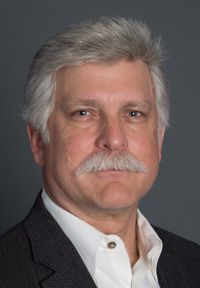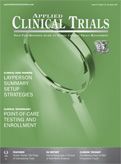Getting Real-World Physicians into Observational Studies
Q&A explores the importance of new vehicles to identify and recruit physicians seeking non-interventional research opportunities.
At the June DIA Annual Meeting in Chicago, Applied Clinical Trials spoke with Jeff Trotter, president of Continuum Clinical, a healthcare research and communications company, in advance of Continuum’s announcement that it was partnering with online medical community provider Skipta to launch the Center for Observational Research, and recruit physicians for observational studies.
Q:Can you tell us more about Continuum Clinical, how it was founded and its goals?
TROTTER: Continuum Clinical has over 30 years of experience. We address our clients’ needs spanning clinical and commercial development. We help life sciences companies engage with key stakeholders, including patients, physicians, and payers. Our patient recruitment and retention practice focuses both on
Jeff Trotter

motivating patients to participate in clinical research, and on supporting the sites at which the studies are undertaken. Our late-stage research practice supports the development of real-world evidence through observational studies, registries, and health economics and outcomes research. Ultimately, our late-stage findings help physicians and payers better understand the clinical, economic, and humanistic value of innovative products and, in so doing, accelerate market acceptance. We work with professionals in clinical trial operations, medical affairs, health economics, patient advocacy, and product management.
Q:Can you explain why you chose Skipta and what you expect from the partnership?
TROTTER: Physicians are increasingly looking online for activities ranging from CME (continuing medical education) to professional interaction to treatment guidelines to research opportunities. Skipta’s engaged online specialist communities was an obvious solution to our need to identify potential physician participants for observational studies and registries. And, Skipta recognized that its nearly 600,000 members would welcome the opportunity to be involved in observational studies that generate important findings on treatment outcomes of actual practice. This partnership will benefit physicians seeking non-interventional research opportunities; our life sciences industry clients looking to expedite their observational studies; and, ultimately, patients through the generation of data on what works in the real world.
Q:Is the Center for Observational Research a separate entity or the name of the partnership?
TROTTER: The Center is the intellectual capital of both Continuum and Skipta, so it’s a collaboration within a virtual community. The Center “exists” within the Skipta domain-where it can be optimally accessible to Skipta’s physician communities, whereas the content-observational study listings-is supplied and curated by Continuum.
Q:What are the primary drivers for recruiting physicians into observational trials?
TROTTER: Practicing physicians-as opposed to academic clinical trialists-are focused primarily on patient care. The outcomes of day-to-day patient care represent the foundation for observational studies that seek to “look over the shoulders” of patients and physicians. Hence, a key driver is to ensure that physicians understand the unobtrusive nature of observational research. While we ultimately need to assess that the suitability of any physician who, through the Center for Observational Research, expresses interest in a particular study, the efficiency of crowd-sourcing through Skipta is both timely and irresistible.
Q:How do the challenges for physician recruitment different from Phase I through III trials?
TROTTER: Each phase of research in support of drug development appeals to different types of physicians. In our view, however, the more important distinction is study design rather than drug development phase. Studies designed to support regulatory approval for market release are generally the province of academic physicians who thrive on interventional, experimental trials; whereas observational, real-world studies (which can be undertaken both pre- and post-approval) require real-world physicians. The challenge in recruiting real-world physicians is ensuring that the observational study is as compatible with actual practice conditions as possible. In many ways, Continuum’s late-stage practice is purpose built to design and implement observational studies through our years of unique experience, specially trained staff, and analytical acumen. A key benefit of the Center for Observational Research is that, through Skipta, we have access to the right type of physicians and, as such, can expedite recruitment and study completion.
Q:Can you explain how the data you collect will inform the growing need for Real-World Evidence?
TROTTER: Findings from observational research provide key stakeholders (physicians, patients, payers) with compelling evidence of real-world clinical, economic, and/or humanistic value, as well as critical safety data from real-world practice conditions. The real world is, however, often unpredictable-in terms of the considerable variability that exists in the practice of medicine for highly variable patients. Accordingly, we need to ensure the data are of high quality and employ appropriate statistical and analytical techniques. In this way, real-world evidence can compliment findings from more controlled randomized clinical trials. We believe if prospective observational studies are designed and executed with rigor, there is no more robust way today to generate real-world evidence.

Improving Relationships and Diversifying the Site Selection Process
April 17th 2025In this episode of the Applied Clinical Trials Podcast, Liz Beatty, co-founder and chief strategy officer, Inato, discusses a number of topics around site engagement including community-based sites, the role of technology in improving site/sponsor relationships, how increased operational costs are impacting the industry, and more.
Behind the Buzz: Why Clinical Research Leaders Flock to SCOPE Summit
February 7th 2025In this episode, we meet with Micah Lieberman, Executive Conference Director for SCOPE Summit (Summit for Clinical Ops Executives) at Cambridge Innovation Institute. We will dive deep into the critical role of collaboration within the clinical research ecosystem. How do we bring together diverse stakeholders—sponsors, CROs, clinical trial tech innovators, suppliers, patients, sites, advocacy organizations, investors, and non-profits—to share best practices in trial design, program planning, innovation, and clinical operations? We’ll explore why it’s vital for thought leaders to step beyond their own organizations and learn from others, exchanging ideas that drive advancements in clinical research. Additionally, we’ll discuss the pivotal role of scientific conferences like SCOPE Summit in fostering these essential connections and collaborations, helping shape the future of clinical trials. Join us as we uncover how collective wisdom and cross-industry partnerships are transforming the landscape of clinical research.
FDA-Approved Gene Therapy Beqvez Shows Sustained Efficacy, Safety in Long-Term Hemophilia B Trial
April 17th 2025Beqvez (fidanacogene elaparvovec), an FDA-approved one-time gene therapy for hemophilia B, demonstrated sustained factor IX expression, low bleeding rates, and a favorable safety profile over long-term follow-up.